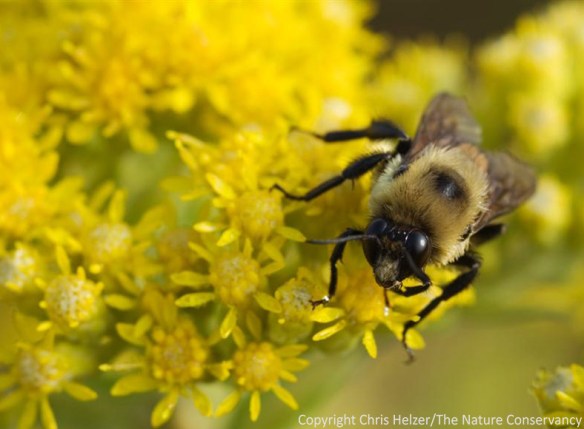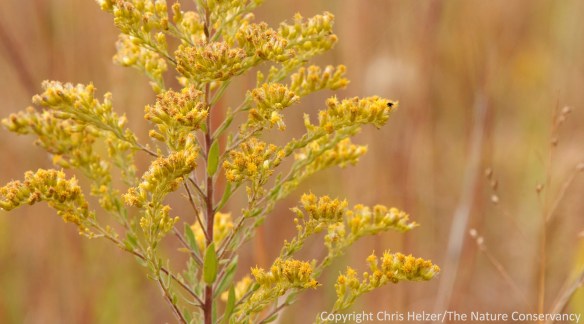Every year at this time, I find myself defending goldenrod from unfair attacks by sneezy, watery-eyed, congested people looking for something to blame for their discomfort.
Poor goldenrod; for a showy native wildflower (actually numerous species of wildflower), it sure has public relations issues. Some species, particularly Canada goldenrod, tend to act pretty weedy – showing up quickly and abundantly in abandoned cropfields and chronically overgrazed pastures. In some cases, it can look much like an invasive plant, causing some (including me) to wonder about whether it warrants some control efforts.
But it’s during allergy season that goldenrod’s reputation takes the biggest hit. When people start to sneeze and wheeze in the late summer/early fall, they look around (through their red puffy eyes) for the culprit, and goldenrod is the tallest, showiest, weediest looking plant they see. Ah ha! That must be the problem plant!
Well, actually…
Allergic reactions to pollen are usually the result of breathing air that contains pollen grains. Our bodies react to the chemicals in those pollen grains, causing symptoms that include sneezing, itchy and watery eyes, congestion, and others. The pollen we breathe in comes from plant species that rely on the wind to transport their lightweight pollen from flower to flower. Those wind-pollinated species make a tremendous amount of pollen to increase the chance that at least some of their pollen grains will get blown toward other plants of the same species.

Grasses, including indiangrass (Sorghastrum nutans) don’t have showy flowers because they don’t need to attract insects to carry their pollen. The wind does the job instead.
In contrast to wind-pollinated plants, plants that are insect pollinated tend to create heavier, stickier, pollen grains that don’t get picked up by the wind. Instead, those plants rely on bees and other insects to carry pollen from flower to flower. To attract pollinators, insect-pollinated plants have to create big, showy, and colorful flowers. Wind-pollinated plants such as grasses, pine trees, and ragweed don’t need to spend resources making big fancy flowers. They just make lots of pollen and let it blow.
Now, consider goldenrod flowers. Definitely showy and colorful, right? That, and the numerous insects crawling around on the flowers make it pretty obvious that goldenrod is insect pollinated. When you walk through a patch of blooming goldenrod, you’ll never see a big poof of pollen come off the flowers as you knock into them. Instead the pollen sits tightly on the numerous little flowers, waiting to stick to a fuzzy bee or other insect.

A bumblebee gathering pollen from stiff goldenrod (Solidago rigidus) in a restored prairie near Sutton, Nebraska.
When you look at the evidence, it seems obvious that goldenrod isn’t to blame for our itchy watery eyes and congested noses. How, then, did it become such a hayfever scapegoat?
I think of goldenrod as the kid in class who’s generally a good student, but always dresses a little too flashy and laughs a little too loud. Ragweed, on the other hand, is like the plain-dressed quiet kid who throws spitballs at the teacher when her back is turned. When the teacher whips around to see who’s responsible for the spitball in her hair, who do you think she’s going to blame? The loud kid who’s laughing uproariously, or the quiet kid pretending to read his lesson?
Exactly.
Poor goldenrod…

Western ragweed (Ambrosia psilostachya) has tiny non-descript flowers, but produces LOTS of pollen, which is released into the wind for transport. Ragweed species are a major contibutor to seasonal allergy attacks.
Well, now that you are in the know, maybe you can help me restore the good name of this much-slandered native plant. Just think of the popularity you’ll gain when you walk up to your puffy-eyed friends and explain to them (between their sneezing attacks) the ecology of wind and insect-pollinated plants! To really drive the point home, maybe you should grab a bouquet of goldenrod flowers and shake them in your friend’s face to prove that no pollen comes out.
Just be sure to check for bees first.


You are such an entertaining writer! I forwarded this one on – just last week we were discussing goldenrod and . I knew the real culprit – but it’s wonderful to have such a well-described, humorous and easily understandable source to share with someone who didn’t.
Reading through a pollination ecology textbook recently (it’s fascinating reading), I learned that bees will sometimes collect grass pollen. In most cases, they don’t act as pollinators, but there are a few examples in the literature of grasses that could be at least partially pollinated by bees. I haven’t spent enough time watching bees to observe this myself; have you?
I know they are found on grasses sometimes, including corn! I’m not sure if they do the plants much good, but assume they can get nutrition out of grass pollen just as they do from pollen of other species. I don’t know much more than that.
I believe it was the false allegations regarding allergies that cost Goldenrod its status as the State Flower of Alabama, back in 1959. Since then it’s been the Camellia. Camellias are pretty, but I’d prefer that a native wild-flower represent the state.
I have been defending goldenrod for years. Problem is the suffers don’t want to hear it. And most people dont know what rag weed looks like. It grows in a weedier side of my yard so I get several comments each year.
Where does one send the check to the “Goldenrod Anti-Defamation League”?
Looking forward to an installment on the benefits of ragweed.
I’m going to forward this to several friends (and my asthmatic daughter-in-law). I have for years encouraged a giant (and very weedy looking) patch of goldenrod immediately next to our backyard deck, partly for a privacy screen during growing season, but mostly for the amazing sprays of golden flowers in autumn that last in this Southern climate well into December. Ragweed is a terrible problem in Texas (along with Mountain Cedar and numerous other allergenic plants). I suffer from ragweed allergies myself; but at least I know the beautiful goldenrod is not to blame.
I think that Disney is somewhat to blame. Remember the scene in Snow White and the Seven Dwarfs when Snow White comes in with goldenrods and the dwarfs yell “GOLDENRODS”! And then they all start sneezing – particularly (of course) Sneezy….
I’d forgotten that – great catch!
Thanks for the helpful article. However, I just did a search on Google Images for ‘ragweed’ – and photos of goldenrods in bloom are also included (although clicking on most of them clarifies the difference). No wonder people are confused!
Thanks for great article on Goldenrod! Out watering this morning and came across this interesting sight, a black wasp with white stripes with beautiful deep blue wings on our Sedum. What was he after? Nectar or insects? Thanks for your posts Patsy Mettenbrink , Grand Island
Sent from my iPhone
Hi Chris, I noticed Dodder was parasitizing Tall Goldenrod and other Aster family members at a local nature preserve. I mentioned this to Stephen Packard on his blog when he wrote about the aggressiveness of Tall Goldenrod. I am planning to collect some seed of Dodder from a local city park and see if it can be used to reduce the abundance of Tall Goldenrod and Sawtooth Sunflower in restorations there restoration areas. I think Stephen will be doing the same. We will all have to see how this experiment works out. It may save Stephen some scything. It would be good if this could free up his time so he could work on other things.
Sincerely,
James
I had no idea I was blaming the wrong plant all these years! Thanks for the info!
I have been a late-season pollen allergy sufferer for decades, and years ago, a field ecology professor “set me straight” about the true source of my seasonal malaise, recounting a similar explanation to Chris’ regarding ragweed versus goldenrod. For years thereafter, I passed along this clarification to others as it certainly made sense to me as an ecologist. But then one evening I found myself repeating this story once again to a group of friends who had assembled for a long night of cards around a table on which sat a large vase of flowering goldenrod. I had scarcely finished my story before the sneezing began, and within a half hour, all of the seasonal pollen allergy-sufferers in the group – myself included – were thoroughly miserable. We decided to ignore “science” and put the much-maligned goldenrods out the back door. As the evening progressed, we all gradually recovered.
This experience proves nothing, of course. Anecdotes are no more reliable sources of truth than is “conventional wisdom.” Maybe we all were also allergic to cats, and a cat slipped out the door unnoticed at the same time we put out the goldenrods. But this experience – along with many others of a similar nature – has made me much more cautious about accepting as “truth” something that is oft-repeated, even when it seems to make sense. Sometimes it is worth spending a little extra time to see whether there is solid evidence to back up those things that we consider “true.” Perhaps goldenrod pollen is much more antagonistic in miniscule doses to some allergy sufferers than is ragweed. Or perhaps people are more likely to “see” goldenrod flowers with their fingers, and end up vectoring its pollen to their eyes. Or maybe it was just a cat.
How about let’s get empirical here? I suggest all you ragweed/goldenrod sufferers set yourself up some nice monocultural vases of flowers (no mixed bouquets for this experiment) and invite each other over for a weekend poker tournament. Every few hours, switch the vases between goldenrod and ragweed, and plot up a graph of winnings (or sneezes) versus centerpieces. It could be illuminating – or not.
I love it! Thanks Peter. Of course, another alternative hypothesis would be that the goldenrod in your vase had been covered with ragweed pollen (as are many other plants that time of year) and that the ragweed pollen was blowing around the room as you played cards. Who knows? Anyway, to make your proposed experiment valid, we should all take a air compressor to the goldenrod before bringing it in the house… : )
Pingback: A Lot of Gall | Tuesdays in the Tallgrass
Pingback: Solida-GO! – Ecological Relationships
I’m one of the lucky ones in that I only have food allergies. I’m an avid native plant gardener without any plant allergies. There’s a simple rule of thumb (odd saying, that one). If a plant is pollinated by insects people usually aren’t allergic to it’s pollin, as the pollen is not spread by the wind and you don’t breath it in.
Lawns usually contain 75% Kentucky Bluegrass, which is the highest rated allergen plant that I’ve heard of. So, instead of blaming plants pollinated by insects, reduce your lawn size to what you actually use, cut your grass before it flowers and plant pollinator friendly plants which don’t cause any allergic reaction.
Just think, you might join up with other gardeners to create safe pollinator habitat trails from Canada to South America. What a gift that would be to our environment.